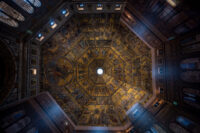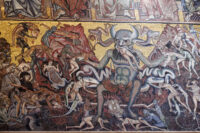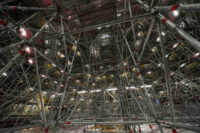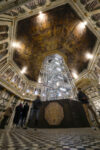 The resplendent 13th century mosaics that cover the cupola of the Baptistery of San Giovanni in Florence are undergoing a comprehensive six-year restoration that will repair hundreds of square feet of detaching tesserae, prevent future deterioration and revive the shine and color of the glass tesserae. This is the final phase in the restoration of the Baptistery of Florence that began in 2014 with repairs to the external façade and roof. Between 2017 and 2022, the white and green marble and mosaics on the eight internal walls of the Baptistery were restored. The project is expected to be completed in 2028.
The resplendent 13th century mosaics that cover the cupola of the Baptistery of San Giovanni in Florence are undergoing a comprehensive six-year restoration that will repair hundreds of square feet of detaching tesserae, prevent future deterioration and revive the shine and color of the glass tesserae. This is the final phase in the restoration of the Baptistery of Florence that began in 2014 with repairs to the external façade and roof. Between 2017 and 2022, the white and green marble and mosaics on the eight internal walls of the Baptistery were restored. The project is expected to be completed in 2028.
 The mosaics were made on preparatory drawings by Gothic masters including Cimabue and Coppo di Marcovaldo. The main theme is the Last Judgment, with a giant figure of Christ the judge presiding between tiers of angels, demons and souls going to heaven or hell. Work on the mosaics of the cupola began around 1225 and in the beginning Florence had no local mosaicists to take on such a huge prestige project. Artists had to be brought in from the outside. Florentine artists worked as assistants on the installation, however, and they learned their trade so effectively that by the end of the century generations of mosaicists had established themselves as some of the most skilled in Italy. Ultimately more than 1,000 square meters (10,764 square feet) of mosaics made using 10 million polychrome tiles varying in size from 5 to 20 mm (.2-.8 inches) per side went into the adornment of the octagonal cupola. There are more than 100 square meters of gold mosaic tiles alone. (Incidentally, they were made using the gold leaf in a glass sandwich technique used to create the recently-discovered gold glass of Rome.)
The mosaics were made on preparatory drawings by Gothic masters including Cimabue and Coppo di Marcovaldo. The main theme is the Last Judgment, with a giant figure of Christ the judge presiding between tiers of angels, demons and souls going to heaven or hell. Work on the mosaics of the cupola began around 1225 and in the beginning Florence had no local mosaicists to take on such a huge prestige project. Artists had to be brought in from the outside. Florentine artists worked as assistants on the installation, however, and they learned their trade so effectively that by the end of the century generations of mosaicists had established themselves as some of the most skilled in Italy. Ultimately more than 1,000 square meters (10,764 square feet) of mosaics made using 10 million polychrome tiles varying in size from 5 to 20 mm (.2-.8 inches) per side went into the adornment of the octagonal cupola. There are more than 100 square meters of gold mosaic tiles alone. (Incidentally, they were made using the gold leaf in a glass sandwich technique used to create the recently-discovered gold glass of Rome.)
 The six-year restoration project is the first in over a century. It initially involves conducting studies on the current state of the mosaics to determine what needs to be done. The expected work includes addressing any water damage to the mortar , removing decades of grime and reaffixing the stones to prevent them from detaching.
The six-year restoration project is the first in over a century. It initially involves conducting studies on the current state of the mosaics to determine what needs to be done. The expected work includes addressing any water damage to the mortar , removing decades of grime and reaffixing the stones to prevent them from detaching.
“(This first phase) is a bit like the diagnosis of a patient: a whole series of diagnostic investigations are carried out to understand what pathologies of degradation are present on the mosaic material but also on the whole attachment package that holds this mosaic material to the structure behind it,” Beatrice Agostini, who is in charge of the restoration work, said.
The Baptistry of San Giovanni and its mosaics have undergone previous restorations over the centuries, many of them inefficient or even damaging to the structure. During one botched effort in 1819, an entire section of mosaics detached. Persistent water damage from roof leaks did not get resolved until 2014-2015.
Roberto Nardi, director of the Archaeological Conservation Center, the private company managing the restoration, said the planned work wouldn’t introduce any material that is foreign to the original types of stone and mortar used centuries ago.
 To reach the entire surface of the vaulted ceiling without completely filling the comparatively small footprint of the Baptistery with scaffolding, experts designed an innovative mushroom-shaped structure that delivers a massive walkable surface of 618 square meters (6652 square feet) occupying just 63 square meters (678 square feet) of floor area. The stem of the mushroom doubles as a staircase that allows workers and the public easy access to the landing 57 feet above the ground. A construction ladder then leads up to a second landing 97 feet from the ground.
To reach the entire surface of the vaulted ceiling without completely filling the comparatively small footprint of the Baptistery with scaffolding, experts designed an innovative mushroom-shaped structure that delivers a massive walkable surface of 618 square meters (6652 square feet) occupying just 63 square meters (678 square feet) of floor area. The stem of the mushroom doubles as a staircase that allows workers and the public easy access to the landing 57 feet above the ground. A construction ladder then leads up to a second landing 97 feet from the ground.
 The stairs will be put to the best possible use: to give the public the unique chance to view the mosaics of the dome up close. That means coming eye-to-eye with demons eating damned souls head first, a motif in medieval art that never fails to entertain even from a great distance. These special visits start on February 23rd and must be booked online here.
The stairs will be put to the best possible use: to give the public the unique chance to view the mosaics of the dome up close. That means coming eye-to-eye with demons eating damned souls head first, a motif in medieval art that never fails to entertain even from a great distance. These special visits start on February 23rd and must be booked online here.
This video shows a timelapse of the scaffolding being built with connecting aluminum poles that is like the biggest, coolest Erector Set you’ve ever seen. An octagonal mesh screen microprinted with an image of the mosaics is then dropped into place under the working platform so people can still get a sense of what they look like from the ground. That is followed by close-up views of the mosaics, including the demons eating people. (Click “More” for a tiny transcript of the annotations in the video.)
:22 — More than 1,000 square meters of mosaics created using 10 million polychrome tiles
:32 — Scaffolding height: 31.5 meters, diameter 25.5 meters
:39 — Scaffolding elements used: 8,150
* This article was originally published here


The six-year restoration project is the first in over a century. It initially involves conducting studies on the current state of the mosaics to determine what needs to be done. The expected work includes addressing any water damage to the mortar , removing decades of grime and reaffixing the stones to prevent them from detaching.









No comments:
Post a Comment